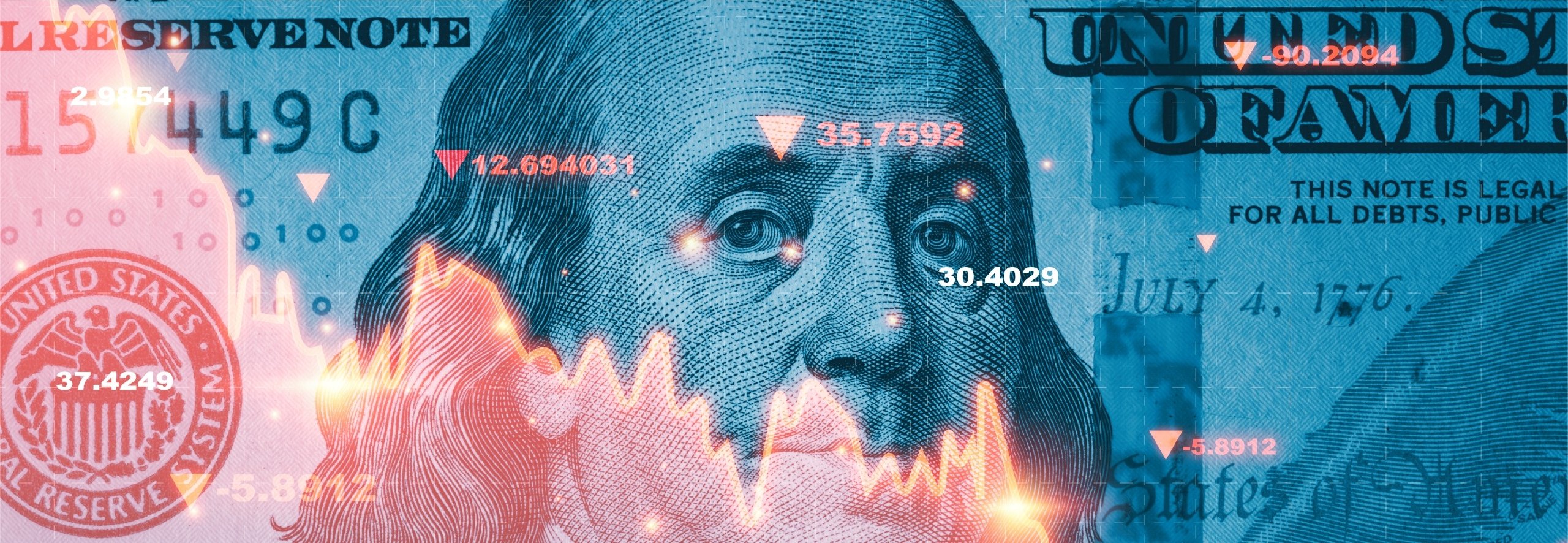Cornell professor of trade policy: Digital revolution will transform currencies—and the world
IN BRIEF
- Physical money is slated to become a relic, with digital payment systems becoming the norm around the world. Whether that leads to greater economic efficiency, or a dystopian society—or both—remains to be seen.
- Despite all the hype, the proliferation of cryptocurrencies will not have a substantial disruptive effect on the major reserve currencies, especially the U.S. dollar. Unbacked cryptocurrencies are much too volatile to be considered stable sources of value or reliable mediums of exchange.
- Digital “smart money” that replaces cash could become an instrument of government control, with authoritarian governments using it as a surveillance tool and even benevolent governments conceivably using it to promote social objectives.
Eswar Prasad is the Tolani Senior Professor of Trade Policy at Cornell University, as well as a Senior Fellow at the Brookings Institution, where he holds the New Century Chair in International Economics, and a Research Associate at the National Bureau of Economic Research. Prasad sits down with Joe Kornik, Editor-in-Chief, VISION by Protiviti, to discuss his latest book, the digital revolution and the future of money.
Kornik: The subtitle of your outstanding book, “How the digital revolution is transforming currencies and finance,” is provocative, to say the least. Let’s start with the end of physical cash. When, why and how do you see it going away and what are the impacts of the digital currencies that replace it?
Prasad: The era of cash is drawing to an end, with its use declining in virtually every economy, including some economies where it is barely even used. Digital payments have many merits. They are quicker and often cheaper. For businesses, it is a boon not to have to deal with transacting in and managing cash. For a street vendor or a mom-and-pop store, handling cash and making change is a hassle. Storing and managing cash is generally messier, time-consuming, and increases vulnerability to theft and loss.
For all its flaws, cash also has many advantages. It is easily accessible, can be used without any electronic device or connection to wireless networks or the internet, and is available to rich and poor alike. Cash also comes through in a pinch, especially during natural disasters and other emergencies, when communications networks might be down and electricity can get cut off. Most importantly, it provides privacy in commercial transactions, an attribute that is unlikely to be true of any form of money that leaves a digital trail.
Will the disappearance of cash matter? Advocates for cash have made the case that it remains essential for a significant share of the population in any economy—those who might not have easy access to digital technologies, including the poor; residents of remote, rural areas; and the elderly. Digital payments such as ApplePay are easy to use but you need a bank or credit card account before you can sign up. So, the non-acceptance of cash could disenfranchise the poor, who already suffer from various deprivations and lack access to the financial system. Besides, cash is often inextricably tied up with national identity. Countries regularly redesign and modernize their banknotes to reflect their national heritage and values while trying to stay a step ahead of counterfeiters.
Despite all this, the reality is that physical money is slated to become a relic, with digital payment systems becoming the norm around the world. Soon, we will live in a world where our smartphones displace our billfolds and physical wallets, much like they eliminated the need for cameras and GPS devices. Whether that leads to greater economic efficiency, or a dystopian society—or both—remains to be seen.
Advocates for cash have made the case that it remains essential for a significant share of the population in any economy—those who might not have easy access to digital technologies, including the poor; residents of remote, rural areas; and the elderly.
Kornik: How do you see that race for digital currency dominance playing out—from Bitcoin to central banks to private companies like Amazon or Meta developing their own cryptocurrencies?
Prasad: The emergence of the original cryptocurrency, Bitcoin, was aimed at making it easy, in principle, for anyone to have access to a means of payment without having to rely on a commercial bank, credit card company, or even money issued by a central bank. The fact that transactions using Bitcoin could be conducted using just the digital identities of the transacting parties, thereby preserving anonymity, was an added allure. However, Bitcoin’s unstable value and its inability to handle more than a tiny volume of transactions have made it a non-viable medium of exchange. New cryptocurrencies called stablecoins aim to fix the problem of unstable value. Their stable value comes from being backed by stores of existing fiat currencies. There are already stablecoins such as Tether and USD Coin that are backed up one-to-one by U.S. dollar reserves. These stablecoins are being used for payments within and perhaps someday even across countries.
Allowing major corporations such as Meta and Amazon to issue their own stablecoins could pose a threat to governments’ monetary sovereignty. After all, global corporations that have widespread reach and deep pockets could someday conceivably issue currencies that are delinked from and directly compete with existing fiat currencies.
Spurred by these innovations and faced with the declining use of cash, many central banks around the world are experimenting with or already rolling out digital versions of their currencies. Central bank digital currencies (CBDCs) have many advantages. They can provide a free and convenient digital payment system for the masses, even those without a bank account or the means to acquire a credit card. Digital currencies will bring economic activity out of the shadows and raise government revenues by making it difficult to conceal transactions that are subject to taxes. Counterfeiting of currency will become harder, but digital hacks cannot be ruled out. Ironically, offshoots of Bitcoin’s technology might help in improving security. The use of currency for money laundering, terrorism financing, and other nefarious activities will be curtailed.
Kornik: Do you think we’re looking at either a weakened U.S. dollar or even perhaps the end of it being the dominant global currency?
Prasad: New financial technologies, including the advent of cryptocurrencies and CBDCs, have implications for the international monetary system. Take cross-border payments, which are inherently complicated, as they involve multiple currencies, institutions operating on different technological protocols, and varying sets of regulations. As a result, international payments tend to be slow, expensive, and difficult to track in real time. New technologies are reducing these impediments, with nearly instantaneous payment and settlement becoming possible.
The landscape of global reserve currencies may appear to be at the threshold of disruption as cryptocurrencies gain traction as mediums of exchange and stores of value. In reality, despite all the hype, the proliferation of cryptocurrencies will not have a substantial disruptive effect on the major reserve currencies, especially the U.S. dollar. Unbacked cryptocurrencies are much too volatile to be considered stable sources of value or reliable mediums of exchange. On the other hand, stablecoins backed by major corporations such as Amazon are likely to gain traction as means of payment. But insofar as their stable values depend on their being backed by fiat currencies, stablecoins are unlikely to become independent stores of value.
global corporations that have widespread reach and deep pockets could someday conceivably issue currencies that are delinked from and directly compete with existing fiat currencies.
Kornik: So, what does all that mean for the future of the global economy?
Prasad: The landscape is likely to shift a great deal, especially for smaller and less developed economies. National currencies issued by their central banks could lose ground to private stablecoins and perhaps also to CBDCs issued by the major economies. Even among the major reserve currencies, there are some shifts in store. The U.S. dollar could lose some ground as a payment currency, although it will remain dominant both in this dimension and as a store of value. A digital version of the Chinese renminbi could help it gain traction as a payment currency but the digitization of the currency by itself will do little to boost its status as a reserve currency, one that is held as a store of value by domestic and foreign investors. The renminbi’s further rise, even if gradual and modest, and the advent of additional stablecoins, could reduce the importance of the second-tier reserve currencies, including the euro, the British pound sterling, the Japanese yen, and the Swiss franc.
Kornik: What if we get this right? What are the positive outcomes of this finance and currency revolution? And, conversely, what could go wrong? What worries you about the financial future?
Prasad: The blockchain technology pioneered by Bitcoin has the potential to make low-cost digital payments widely accessible. Many low-income households even in the U.S. lack access to digital payments because they do not have a credit card or bank account. International payments, which are beset by even more impediments, could also be made cheaper, quicker, and easier to track. These changes will be a boon to consumers, businesses, as well as exporters and importers.
Blockchain might soon play a bigger role in other areas of finance as well. Variants of the original technology could someday make it easier to connect savers and borrowers directly, sidestepping banks and other conventional lenders. “Decentralized finance” is viewed by proponents as a way to democratize finance, enabling broader and easier access to a wide array of financial products and services. The prospect of easy access to digital payments and basic banking products for savings and credit is one that could be beneficial not just in developing countries but even in a rich country like the U.S., where about 5 percent of the adult population is cut off from the formal financial system.
But technology can’t solve all the problems and will create new ones. Financial regulators face significant challenges with updating regulations to cover cryptocurrencies and related financial products that often fall between the regulatory cracks. Investor protection is a serious concern as naïve, retail investors might end up taking on more risk than they realize when they get dazzled by the promise of a quick pathway to riches from the new technologies.
Kornik: I don’t mean to focus only on the what could go wrong, but I wonder how you think we can combat issues around privacy, data security, fraud and even financial crimes in a digitized future?
Prasad: Some of the advantages of digital currencies discussed earlier come with a price. Electronic transactions leave a digital trail that cannot easily be erased. Even with privacy protections in place, the reality is that transactions using a central bank digital currency will be auditable and traceable. After all, every central bank wants to do all it can to ensure that its currency, physical or virtual, does not facilitate illicit commerce.
The U.S. dollar could lose some ground as a payment currency, although it will remain dominant both in this dimension and as a store of value. A digital version of the Chinese renminbi could help it gain traction as a payment currency but the digitization of the currency by itself will do little to boost its status as a reserve currency.
Electronic money offers possibilities that cash cannot. For instance, in an economic crisis, a government could dole out digital money with expiration dates, ensuring that it is spent rather than saved. This makes economic policy more effective but at the same time takes some key decisions out of the hands of households in favor of government-directed outcomes. Digital “smart money” that replaces cash could become an instrument of government control, with authoritarian governments using it as a surveillance tool and even benevolent governments conceivably using it to promote social objectives (preventing its use to purchase goods and services that are deemed illegal or undesirable).
Bitcoin’s blockchain technology can help in creating better digital payment systems, automating a broad range of transactions, and helping to democratize finance. But, in an ironic twist, the true (and dark) legacy of Bitcoin might be the erosion of confidentiality, the broader prevalence of government-managed payment systems, and greater intrusion of big business and governments in financial systems and in the functioning of society.
Kornik: When you look out to 2030 and beyond, what will be the ultimate impact of this digital disruption on people and the planet?
Prasad: In the coming years, central bank-issued currencies will still retain their importance as stable stores of value, reflecting the perceived trustworthiness of their issuers. But when it comes to money’s function as a medium of exchange, we can expect more competition between private and fiat currencies. In principle, intensified competition between currencies should lead to payments that are cheaper and quicker, benefiting consumers and businesses, and also foster incentives for issuers, whether private or official, to exercise discipline in order to preserve the value of their currencies.
But it is worth keeping in mind that technology can have unpredictable consequences. Rather than leading to a proliferation of private and official currencies that compete on a level playing field, the digitization of currencies might eventually result in an even greater concentration of economic power. If they were easily available worldwide in digital form, major currencies such as the dollar, the euro, and the renminbi might displace the currencies of smaller and less powerful nations.
Digital currencies issued by large corporations that take advantage of their already dominant commercial or social media ecosystems might gain traction too and, unless quashed by governments, could one day perhaps even turn into independent stores of value by giving up their fiat currency backing. This could create even more monetary instability if it resulted in individual countries having multiple issuers of money, with domestic currency values fluctuating relative to one another. All that is certain is that the international monetary system is on the threshold of momentous change, wrought by the digital revolution. It remains to be seen whether this ultimately benefits humanity at large or exacerbates existing domestic and global inequities.
the digitization of currencies might eventually result in an even greater concentration of economic power. If they were easily available worldwide in digital form, major currencies such as the dollar, the euro, and the renminbi might displace the currencies of smaller and less powerful nations.
































